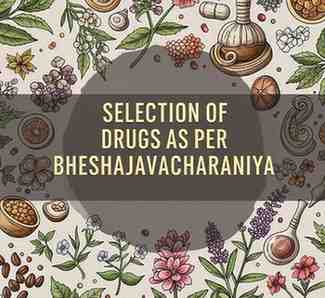
Your Account
Designed by Zeptt Technologies

The selection of suitable drugs for the treatment of various diseases is a critical principle in Dravyaguna Vijnana.
This selection is governed by the Bheshajavacharaniya Adhyaya mentioned in Ashtanga Sangraha Sutrasthana Adhyaya 23.
The correct drug must be chosen after a thorough analysis of the Vyadhi (disease), Rogi (patient), Desha (location), Kala (season and stage of disease) and Dravya Guna (properties of drugs).
This selection follows Ayurvedic principles, supported by modern pharmacological concepts in contemporary herbology and therapeutics.
SANSKRIT REFERENCE
अशुद्धिर्भेषजस्योक्ता न केवलमनौषधम्।
अविचारात्तदाभ्यासो हन्ति भूयो न पालयेत्॥
(Ashta. Sang. Su. 23/1)
MEANING
Improper drug usage due to lack of proper judgment is harmful and must be avoided. Hence, selection of drug requires careful consideration.
FACTORS TO BE CONSIDERED IN DRUG SELECTION
ROGI (PATIENT)
Prakriti (constitution): Choose Sheeta virya drugs in Pitta prakriti and Ushna virya in Kapha prakriti.
Vyadhi bala and Rogi bala: In weak patients, mild drugs should be selected.
Satva and Satmya: Consider psychological tolerance and habitual foods.
ROGA (DISEASE)
Dosha involvement:
Vata: Choose drugs with Snigdha, Ushna, Madhura properties like Ashwagandha, Eranda.
Pitta: Select Sheetala, Tikta, Madhura drugs like Guduchi, Chandana.
Kapha: Use Ushna, Tikshna, Katu drugs like Pippali, Shunthi.
Srotas involvement: Use drugs that target specific systems e.g., Vasa for respiratory, Punarnava for renal.
SANSKRIT SHLOKA
रोगिणः प्रकृतिं दृष्ट्वा दोषं दोषबलं तथा।
औषधं योग्यं प्रयोग्यं सविस्तरविनिश्चितम्॥
(Ashta. Hr. Su. 1/12)
DESHA (REGION OF THE PATIENT)
Jangala Desha (dry regions): Use Snigdha and Madhura drugs like Yashtimadhu.
Anupa Desha (marshy regions): Use Tikta, Katu and Laghu drugs like Triphala.
KALA (TIME & SEASON)
Ritukala:
In Grishma (summer): Use Sheetala and Madhura drugs.
In Shishira (winter): Use Ushna and Snigdha drugs.
Avastha (stage of disease):
In acute stage: Use Tikta, Katu and Laghu drugs.
In chronic stage: Use Brimhana and Rasayana drugs.
SANSKRIT REFERENCE
देशं कालं बलं शीलं आयुः सत्त्वं प्रकृतिं।
सात्म्यं दोषं च विकारं च लक्षणं च परीक्ष्य वै॥
भिषक् सम्यक् भिषक् श्रेष्ठो भिषक्तम इति स्मृतः॥
(Cha. Su. 9/24)
VYADHI AVASTHA (STAGE OF DISEASE)
Samprapti (pathogenesis): Identify the stage of dosha involvement.
In Ama stage: Avoid heavy drugs; prefer Deepana and Pachana like Chitraka, Musta.
In Nirama stage: Use Shodhana or Rasayana based on the condition.
DRAVYA GUNA VIJNANA (PROPERTIES OF DRUG)
Rasa (taste):
Tikta – Anti-inflammatory, antipyretic
Katu – Digestive, fat-burning
Madhura – Nutritive, soothing
Virya (potency):
Ushna virya drugs are good for Kapha and Vata disorders.
Sheeta virya drugs are good for Pitta disorders.
Vipaka (post-digestive effect):
Madhura Vipaka – Rasayana, anabolic
Katu Vipaka – Detoxifying, catabolic
MODERN CORRELATION
Herbal pharmacology uses drug selection based on active constituents, therapeutic action, bioavailability and disease specificity.
Example:
Curcuma longa (Haridra): Anti-inflammatory in skin and joint disorders.
Withania somnifera (Ashwagandha): Adaptogen in stress, rejuvenation.
Tinospora cordifolia (Guduchi): Immunomodulator in fevers and auto-immune diseases.
Clinical pharmacokinetics and pharmacodynamics help in understanding drug action and appropriate usage in modern medicine.
IMPORTANT EXAMPLES OF DRUG SELECTION BASED ON BHESHAJA VICHARA
Jwara (fever): Use Guduchi, Musta, Kiratatikta – Tikta rasa, Ushna virya.
Shvasa (asthma): Use Vasa, Kantakari, Pippali – Katu rasa, Kapha-Vata hara.
Amlapitta (acid dyspepsia): Use Yashtimadhu, Chandana, Amalaki – Sheeta virya, Pitta hara.
Kustha (skin diseases): Use Haridra, Manjistha, Khadira – Raktashodhaka, Tikta-Kashaya rasa.
Mutrakrichra (UTI): Use Punarnava, Gokshura, Varuna – Mutrala, anti-inflammatory.
INTEGRATIVE APPROACH FOR MODERN MEDICAL STUDENTS
Understanding drug formulations, pharmacognosy, phytochemistry and clinical application in line with Ayurvedic principles.
Standardization and evidence-based usage of herbal drugs enhances therapeutic outcomes.
Application of modern diagnostic tools and Ayurvedic assessment aids in rational drug selection.